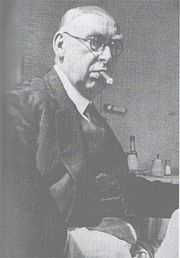Hans-Thilo Schmidt
| Hans-Thilo Schmidt | |
|---|---|
| Born | 18 May 1893 |
| Died |
19 September 1943 Berlin, Germany |
Cause of death | Execution or Suicide |
| Nationality | German |
| Occupation | Civil servant |
Hans-Thilo Schmidt (13 May 1888 – 19 September 1943) codenamed Asché or Source D, was a spy who, during the 1930s, sold secrets about the Germans' Enigma machine to the French. The materials he provided facilitated Polish mathematician Marian Rejewski's reconstruction of the wiring in the Enigma's rotors and reflector; thereafter the Poles were able to read a large proportion of Enigma-enciphered traffic.
Selling Enigma secrets

In the early 1930s, Schmidt was an employee at the German Armed Forces' cryptographic headquarters, the Cipher Office. Shortly after the military version of the Enigma machine was introduced, he contacted French intelligence and offered to supply information about the new machine. His offer was accepted by Captain Gustave Bertrand of French Intelligence, and he received from the French the codename Asché, and was assigned a contact, the French agent codenamed Rex.
For the next several years, until he left his position in Germany, he met with French agents at various European cities and supplied them copies of the Enigma machine's instruction manual, operating procedures, and lists of key settings. Even with this information, however, French Intelligence was unable to break messages encrypted on the Enigma. Nor were the British cryptologists whom Bertrand contacted able to make any headway.
In December 1932, Bertrand shared intelligence obtained from Asché with the Polish General Staff's Cipher Bureau (Biuro Szyfrów). Mathematician-cryptologist Marian Rejewski had already set up a system of equations describing the operation of the then new German Army Enigma rotor-wirings. The key-settings lists provided by Schmidt helped fill in enough of the unknowns in Rejewski's formulae, allowing him to speedily solve the equations and recover the wirings. That accomplished, the Poles were henceforth able to read Enigma traffic for nearly seven years to the outbreak of World War II as well as for a time into the War, while operating in conjunction with French intelligence in France. In a two-week January 1938 trial, they solved and read about three-quarters of all German Wehrmacht — Army — Enigma intercepts: a remarkable result, considering that parts of the raw intercepts were garbled or incomplete due to interference [Kozaczuk, Enigma 1984, p. 45].
After the Battle of France, the French agent who had been Schmidt's case officer, a German citizen named Stallmann who went by the name "Rodolphe Lemoine" and used the codename "Rex," was arrested by the Gestapo and betrayed Schmidt as a French spy. Schmidt was arrested on 1 April 1943, and in September 1943 his daughter Giselle was called on to identify his body; her account (as recounted in Sebag-Montefiore's book) suggests that Schmidt may have committed suicide. His older brother was the general Rudolf Schmidt.
See also
References
- Gustave Bertrand, Enigma ou la plus grande enigme de la guerre 1939-1945 (Enigma: the Greatest Enigma of the War of 1939-1945), Paris, Librairie Plon, 1973.
- Paul Paillole, Notre espion chez Hitler (Our Spy with Hitler), Paris, Editions Robert Laffont, 1985.
- Władysław Kozaczuk, Enigma: How the German Machine Cipher Was Broken, and How It Was Read by the Allies in World War Two, edited and translated by Christopher Kasparek, Frederick, MD, University Publications of America, 1984.
- Hugh Sebag-Montefiore, Enigma: the Battle for the Code, London, Weidenfeld & Nicolson, 2000. (Provides information on Schmidt obtained from his daughter.)
- Fred B. Wrixon, Codes, Ciphers & Other Clandestine Communication: Making and Breaking Secret Messages from Hieroglyphics to the Internet, 1998, Black Dog & Leventhal Publishers, Inc., ISBN 1-57912-040-7, p. 84.
Further reading
- Nigel West, Seven Spies Who Changed the World. London: Secker & Warburg, 1991 (hard cover). London: Mandarin, 1992 (paperback).
|